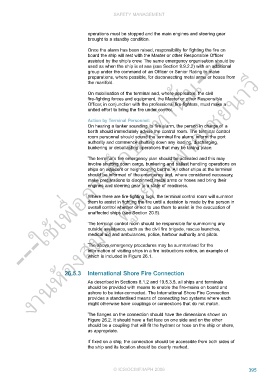Page 429 - International safety guide for oil tankers and terminals
P. 429
SAFETY MANAGEMENT
operations must be stopped and the main engines and steering gear
brought to a standby condition.
---ใช้เพื่อการศึกษาเท่านั้น---
Once the alarm has been raised, responsibility for fighting the fire on
board the ship will rest with the Master or other Responsible Officer
งานห้องสมุด ศูนย์ฝกพาณิชย์นาวี
assisted by the ship’s crew. The same emergency organisation should be
used as when the ship is at sea (see Section 9.9.2.2) with an additional
group under the command of an Officer or Senior Rating to make
preparations, where possible, for disconnecting metal arms or hoses from
the manifold.
On mobilisation of the terminal and, where applicable, the civil
fire-fighting forces and equipment, the Master or other Responsible
Officer, in conjunction with the professional fire-fighters, must make a
united effort to bring the fire under control.
Action by Terminal Personnel:
On hearing a tanker sounding its fire alarm, the person in charge of a
berth should immediately advise the control room. The terminal control
room personnel should sound the terminal fire alarm, inform the port
authority and commence shutting down any loading, discharging,
bunkering or deballasting operations that may be taking place.
The terminal’s fire emergency plan should be activated and this may
ึ
involve shutting down cargo, bunkering and ballast handling operations on
ships on adjacent or neighbouring berths. All other ships at the terminal
should be informed of the emergency and, where considered necessary,
make preparations to disconnect metal arms or hoses and bring their
engines and steering gear to a state of readiness.
Where there are fire-fighting tugs, the terminal control room will summon
them to assist in fighting the fire until a decision is made by the person in
overall control whether or not to use them to assist in the evacuation of
unaffected ships (see Section 20.5).
The terminal control room should be responsible for summoning any
outside assistance, such as the civil fire brigade, rescue launches,
medical aid and ambulances, police, harbour authority and pilots.
The above emergency procedures may be summarised for the
information of visiting ships in a fire instructions notice, an example of
which is included in Figure 26.1.
26.5.3 International Shore Fire Connection
As described in Sections 8.1.2 and 19.5.3.5, all ships and terminals
should be provided with means to enable the fire-mains on board and
ashore to be inter-connected. The International Shore Fire Connection
provides a standardised means of connecting two systems where each
might otherwise have couplings or connections that do not match.
The flanges on the connection should have the dimensions shown on
Figure 26.2. It should have a flat face on one side and on the other
should be a coupling that will fit the hydrant or hose on the ship or shore,
as appropriate.
If fixed on a ship, the connection should be accessible from both sides of
the ship and its location should be clearly marked.
© ICS/OCIMF/IAPH 2006 395

